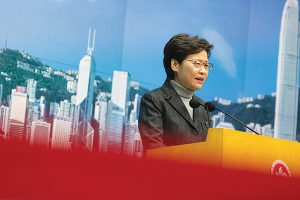Hong Kong’s most unpopular leader since the city returned to Chinese rule stayed in character to the end. Carrie Lam paid tribute to her backers in Beijing, while eschewing any mention of the financial center’s people as she confirmed she won’t seek a second five-year term.
The chief executive put the central authorities first, second and third on her list for thanks. They had shown “understanding and respect†for her decision to conclude a 42-year government career on June 30, she told a press conference. They had placed “support and trust†in her for the past five years. Their “very staunch support†had given her the motivation to carry on when she was under great pressure from the “interference of foreign forces†in Hong Kong and the Covid-19 pandemic. Just for good measure, Lam then thanked by name the central government’s Liaison Office, the Foreign Ministry’s branch in the city, the People’s Liberation Army garrison, and the National Security Office, which is staffed by mainland officials and isn’t subject to Hong Kong jurisdiction.
Lam’s governance style epitomises how the administration of Hong Kong, which was promised a high degree of autonomy after the 1997 handover from Britain, has become more overtly wedded to Beijing’s policy priorities and less responsive to local sentiment. This in turn reflects a China that has grown increasingly hostile to liberal democratic values under the leadership of Xi Jinping. It’s a trend that’s unlikely to change, whatever the cost to Hong Kong’s standing as an international financial hub. Lam, who had earned a reputation as a competent administrator during her long climb through the ranks, once promised to resign if mainstream opinion turned against her, and showed some brief pangs of conscience and self-doubt three years ago, when a policy she championed led to the worst unrest since the return to China.
These days, following Beijing’s imposition of a national security law in 2020, she presents a more high-handed and uncompromising figure, mixing occasional rebukes to journalists with her regular encomiums to the central government.
Any previous chief executive who presided over the disasters that have marked Lam’s tenure would surely have been removed long ago. Hong Kong’s first post-handover leader, Tung Chee-hwa, resigned halfway through his second term after 500,000 people protested in 2003 against proposed national security legislation. In 2019, a demonstration against the extradition bill put forward by Lam’s government drew perhaps four times as many. She has overseen the ensuing erosion of Hong Kong’s freedoms enabled by the national security law, a deterioration that led the US to revoke the city’s preferential trade treatment and to impose sanctions against Lam personally.
Then there is Covid. Hong Kong has isolated itself internationally, contrary to its economic interests and professed ambitions as a global financial center, in conformity with Beijing’s zero-Covid policy. That’s bad enough. What’s worse is that the policy didn’t even work. After months with no cases last year, the Omicron wave exploded in early 2022, leading to one of the world’s deadliest outbreaks. The combination of political change and rigid social-distancing restrictions has caused a record exodus of people, and more businesses — including banks that are integral to the city’s financial role — are rethinking their presence. The pandemic probably pushed the economy back into contraction in the first quarter, after a record shrinkage in 2020, and Goldman Sachs Group Inc forecasts property prices will drop 20% by 2025.
Hong Kong was never very democratic. When the city was a British colony, London appointed its governor. Still, administrations were mindful of public opinion and could be swayed by expressions of the popular will. Governors could be and were recalled and replaced when things weren’t going well. The departure of Tung (ostensibly for health reasons) was a reflection that this social contract continued to prevail after the city’s government started answering to Beijing. Keeping Lam in place in the face of such strong displays of public discontent (which included a landslide defeat for the government in district elections held at the end of 2019) was a signal, then, that the rules had changed. Instead of seeing protests as a legitimate voicing of social concerns, Beijing viewed them as a foreign-directed plot intent on destabilizing China.
So Lam’s departure should not be misinterpreted as China’s government belatedly responding to public pressure. The die was already cast long ago. Nominations for the next chief executive, to be selected by a 1,500-strong committee that has been carefully curated to ensure its loyalty to Beijing, opened Sunday. Only one potential candidate has surfaced so far in local media: John Lee, Lam’s No. 2 and a former secretary for security and deputy police commissioner. That hints at how Beijing continues to view Hong Kong: through a security prism that supersedes all other considerations, including its role as a financial hub. There is no reason to expect this to change.
—Bloomberg
Matthew Brooker is a columnist and editor with Bloomberg Opinion. He previously was a columnist, editor and bureau chief for Bloomberg News. Before joining Bloomberg, he worked for the South China Morning Post
 The Gulf Time Newspaper One of the finest business newspapers in the UAE brought to you by our professional writers and editors.
The Gulf Time Newspaper One of the finest business newspapers in the UAE brought to you by our professional writers and editors.

